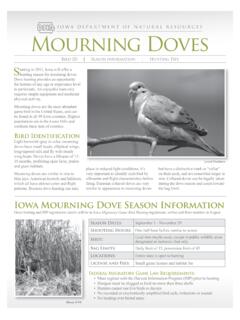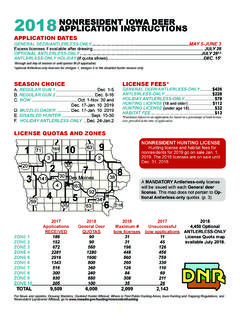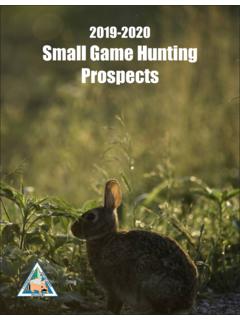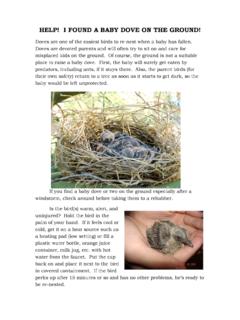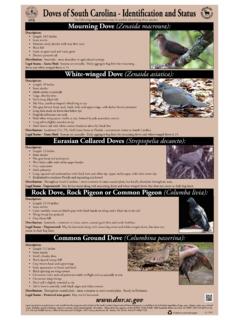Transcription of making a home for wildlife MOURNING DOVES
1 ManagementLocation is not as important as management in attracting DOVES . Control two factors to increase success: So DOVES can forage, create bare ground by mowing, disking, burning and controlling weeds with selective herbicides. Plan ahead and plant so seeds mature by mid- to late August to condition birds to come to food plots before hunting season opens. site preparationKill any grass with herbicide. For best suppression, spray in the fall and spring, although spring spraying may be sufficient if disking before planting. Once grass turns brown, disk up the dead sod. Or if planting wheat or millet, no-till plant right into dead sod. For cropped sites, lightly disk corn stalks or plant right into bean stubble. fertilizationGet a soil test to know appropriate fertilizer amounts. In lieu of soil tests, see general recommendations in Table 3 for each species.
2 making a home for To plant and grow food plots rich in grains that seed-eating DOVES prefer. To help landowners determine plantings and locations suitable for their land, management style and preferred hunt. To ensure plants produce seed by mid-August and leave seed during September. before you beginThe top requirement to attract DOVES is to provide bare ground, where they can forage and walk around on dirt. Many types of food plots attract DOVES . DOVES particularly like sunflowers, but sunflowers have a long growing season and require extensive site preparation. Wheat also works well and needs less site preparation, but requires more planning. Millet varieties and annual weeds are less attractive to DOVES , but can be a great substitute if planting is delayed or for late season hunting.
3 See Tables 1 and 2 as you consider DOVES specific recommendations sunflowers Selecting Seed: Select a seed variety based on maturity dates, generally 90 to 105 days, planting from April 20 to May 10. Planting earlier when soil temperatures are cool may cause seed to rot before germinating. Herbicide: Disk plot once before applying pre-emergents: Treflan and Eptam. Apply a tank mix of 1 quart per acre of Treflan and 1 quart per acre of Eptam. Disk again immediately following application, and again two days after application. If grasses become a problem, use a post-emergent herbicide like Poast or Select. If you can t incorporate, use a tank mix of Prowl and Treflan, or Prowl H2O right after : Use a corn planter, drill or broadcaster to plant sunflowers. A corn planter provides the ideal amount of bare ground.
4 Mowing: To make sunflower seeds more available, mow as soon as seeds mature. Mow part of the food plot each week, increasing the amount mowed closer to Sept. 1. If you have a sickle bar mower and a bush hog,cut the sunflowers first with the sickle bar. After seed heads dry for a couple of days, run a bush hog over the downed heads. Leave some sunflowers standing to conceal hunters. A ratio of 20 to 25 percent standing sunflowers to 80 to 75 percent mowed is considered ideal, but some mow a strip around the plot s edges. Consider skipping mowing if there is already heavy dove use in early- to mid-August (See Diagram 1).wheat Herbicide: Winter or spring wheat food plots should not need herbicide with the possible exception of a glyphosate burndown to prepare site before planting. Planting: Plant wheat food plots using a conventional or no-till : To ensure wheat seeds are available for DOVES , mow, hay, burn or disk it; or use a combination of all four from one month to one day before the season opens.
5 Avoid disturbing the entire field too early because if it rains, wheat seeds may germinate and not be available as food. If you mow, watch how much wheat straw is left on the ground to be sure DOVES can get to the grain easily. If there is too much straw, burn the cut/dried straw about two weeks before season opens. Choose a day with a relative humidity of about 30 percent and wind speeds below 15 mph so straw does not burn too hot and completely consume the seeds. It is a good idea to notify the county dispatcher or sheriff before also creates areas where DOVES can forage. Baling some of the windrows and leaving bales throughout the field provides cover for hunters. Disking standing wheat in areas attracts DOVES by providing grain lying on bare soil. optimum choiceother optionsBird PreferenceSunflowersOther plants also attract sunflowers by May 10 to reach full maturity for dove opener.
6 DOVES migrate south early. Plant millet or weeds if planting is PreparationWheat and millet take less; weeds the leastSunflowers take the mostSite TopographyFlat, tillable groundAvoid steep ground to prevent erosion, low ground subject to flooding, and areas next to water for easy bird retrievalSize10 acres or moreAs small as 1 acre for small hunting groups. Land enrolled in General CRP up to 10 percent of field but 5 acres maximumStrip Width25 yard increments help hunters estimate shooting distances75 yards total disturbed area makes bird retrieval easyHunting PreferencesPlan disturbances for early or late season hunts, depending on preferences. Locate plot so DOVES fly into the sun. See Diagram both early and late may require a larger plot size. Note: DOVES may move south with cold are least expensiveSunflowers are most expensive in cost and managementtable 1: things to considermillet Selecting Seed: Choose a millet variety that produces small seeds more easily eaten by DOVES .
7 Fertilization: Fertilizer is probably more important for millet than for other food plot types. Herbicide: Apply a pre-emergent grass herbicide at the labeled rate prior to planting into disked sod or in a tank mix with the glyphosate used to kill the existing sod for a no-till planting. Planting: Unlike sunflowers, plant millet in closely spaced rows. Mowing/Disking: Mow and lightly disk portions of millet plot after seeds mature, staggering the disturbance so the seeds are gradually available over the two weeks prior to the season opening. Ensure most of the field is disturbed before opening if early hunting is desired. Leave a few strips for hunters to use for cover. (See Diagrams 1 and 2.) annual weeds For an easy, inexpensive and later-yielding dove food plot, disk or spray to set back grass and release annual weed seed.
8 DOVES like common ragweed, foxtail, wild hemp and pigweed. Disturb in spring from frost out to May 15 to stimulate foxtail growth a dove favorite. Disturb ground in fall from Sept. 1 through first killing frost to favor ragweed. Spray when temperatures are above 70 degrees during the day and above 50 degrees at night. Mow or disk after weed seeds have field designThe strips in Diagram 1 run from north to south. Leave the west strip standing if planning to hunt most often in the evening. That provides hunters with a clear view and the DOVES looking into the sun. Reverse the order and dates of management, leaving the strip on the east standing if morning hunting is preferred. Another possibility is for hunters planning to hunt both morning and evening, add a few strips and leave the middle strip standing, managing strips to the east and west of the middle strip.
9 Consider managing half the plot for opening weekend and half for late season hunting as shown in Diagram 1. diagram 1: orientation and management of dove food plotprosconsSunflowers One of best all-around and attractive food plots for DOVES Seed is readily available and inexpensive, may be free from local non-profits if reserved in the fall Can be planted with a corn planter or drill, or broadcast Have longer growing season Early planting may leave seed susceptible to rotting due to high moisture and low soil temperatures Need pre-emergent and often post-emergent herbicide Timing and following management steps (fertilizing, planting, managing weeds, mowing at right time) is difficult Provides little winter cover or food for upland game birdsWheat Fall planting provides more planting time for crops in the spring Seed readily available and inexpensive.
10 No pre- or post-emergent herbicides needed Winter wheat provides fall and early winter forage for deer when planted early enough Late harvest allows much of wheat and straw to be harvested, while still providing a good dove food plot Doesn t attract DOVES as well as sunflowers Plan ahead to seed at right time May mature early and be unavailable for hunting season Timing of mowing, burning, disking or harvesting can be tricky depending on weather, and use by DOVES and songbirds Burning can destroy seed if it s too dry Does not leave much winter cover or food for upland birdsMillet If you miss planting sunflowers or wheat, there s still time to plant some millet varieties Cheap Provides some winter cover and food for upland birds Not as attractive to DOVES as sunflowers and wheat Seed can be harder to find Needs pre-emergent herbicide May not succeed if too dryWeeds Cheap.
